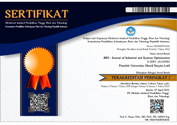PENERAPAN METODE CPM DAN CCPM UNTUK PERENCANAAN SUMBER DAYA DAN WAKTU PENYELESAIAN MULTI PROYEK
DOI:
https://doi.org/10.51804/jiso.v5i2.92-98Keywords:
critical path method, critical chain project management, manajemen proyekAbstract
ABSTRAK
Penelitian ini dilakukan pada perusahaan yang bergerak di bidang supplies dan engineering dan berlokasi di Surabaya. Perusahaan mempunyai beberapa proyek dalam waktu yang dekat maupun bersamaan. Salah satunya adalah proyek alat pengupas bawang dan proyek exhaust silencer yang harus diselesaikan sesuai dengan waktu yang ditetapkan dengan sumber daya yang terbatas. Untuk menyelesaikan hal tersebut maka pentingnya untuk dilakukan perencanaan terhadap jadwal dengan menggunakan metode critical path method dan juga critical chain project management. Pada critical path method bertujuan untuk melihat kegiatan mana saja yang harus menjadi perhatian perusahaan dalam pelaksanaannya agar tidak menyebabkan keterlambatan penyelesaian. Lalu dengan mmetode critical chain project management bertujuan untuk mengatur penjadwalan terhadap tenaga kerja yang melakukan pekerjaan terhadap beberapa proyek. Setelah melakukan analisa, dari hasil penelitian didapatkan untuk proyek alat pengupas bawang pada metode critical path method adalah 56 hari dari waktu normal 59 hari, sedangkan untuk proyek exhaust silencer 46 hari dari waktu normal 47. Lalu untuk metode critical chain project management, kegiatan multiproyek mengalami kemunduran selama 15 hari pada proyek alat pengupas bawang, namun hal tersebut masih berada dalam project buffer.
ABSTRACT
This research was conducted at supplies and engineering company in Surabaya. The company has several projects in the near future or at the same time. One of them is the onion peeler project and the exhaust silencer project which must be completed in accordance with the specified time with limited resources. To solve this problem, it is important to plan the schedule using the critical path method and also critical chain project management. The critical path method aims to see which activities the company should pay attention to in its implementation so as not to cause delays in completion. Then the critical chain project management method aims to regulate the scheduling of workers who work on several projects. After conducting the analysis, the research results obtained for the onion peeler project on the critical path method is 56 days from the normal time of 59 days, while for the exhaust silencer project it is 46 days from the normal time of 47. Then for the critical chain project management method, multi-project activities experience 15 day setback on the onion peeler project, but it's still in the project buffer.
References
Eka H (2017). Analisa Biaya Percepatan Assembly Block DB (Double Bottom) Dengan Metode CPM pada Proyek Kapal LPD (Studi Kasus : Divisi Kapal Niaga PT PAL Indonesia). Skripsi. Tidak Diterbitkan. Teknik Industri. Universitas 17 Agustus 1945: Surabaya
Chatfield, Carl and Timothy Johnson (2013). Step by Step Microsoft Project 2013. Washington : Microsoft Press.
Leach. P. Lawrence (2000). Critical Chain Project Management. London : Artech House.
Punmia, B. C. and K. K. Khandelwal (2002). Project Planning and Control with PERT and CPM. New Delhi: Laxmi Publications LTD.
Santosa, Budi (2009). Manajemen Proyek (Konsep & Implementasi). Surabaya: Graha Ilmu.
Soeharto, Iman (2002). Manajemen Proyek (Dari Konseptual Sampai Operasional) Jilid 1. Jakarta: Airlangga.
Downloads
Published
Issue
Section
License
With the receipt of the article by JISO Editorial Board and the decision to be published, the copyright regarding the article will be transferred to JISO. The copyright transfer form can be downloaded here.
JISO has the right to multiply and distribute the article and every author is not allowed to publish the same article that was published in this journal.
JISO is licensed under a Creative Commons Attribution-ShareAlike 4.0 International License.
Under the following terms:
Attribution — You must give appropriate credit, provide a link to the license, and indicate if changes were made. You may do so in any reasonable manner, but not in any way that suggests the licensor endorses you or your use.
ShareAlike — If you remix, transform, or build upon the material, you must distribute your contributions under the same license as the original.














